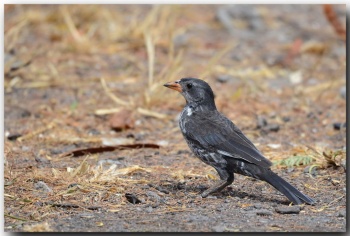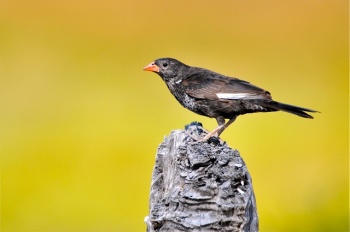- Bubalornis niger
Identification
22 cm (8¾ in)
Male
- Black with whitish patches on wings
- Red or sometimes orange bill
Female and juvenile: brown above and spotted or streaked below.
Similar species
Very similar in habit and appearance to the White-billed Buffalo-Weaver.
Distribution
Africa:
Western Africa: found in Angola
Eastern Africa: Sudan, South Sudan, Ethiopia, Somalia, Kenya, Uganda, Tanzania, Zambia, Mozambique
Southern Africa: Namibia, Botswana, Zimbabwe, South Africa, KwaZulu-Natal, eSwatini
These birds are known to be somewhat nomadic but are generally described as common.
Taxonomy
Subspecies
Bubalornis niger has two subspecies:1
- B. n. niger
- Southern Angola to Zambia, Mozambique and north-eastern South Africa.
- B. n. intermedius
Habitat
Dry thornveld with mopane and mixed acacia-baobab.
Behaviour
Diet
Their diet consists almost entirely of insects such as weevils and grasshoppers.
Breeding
They construct huge nests made from thorny sticks in baobabs and other large trees, as well as on power pylons; these are used as communal roosts. They may have a second brood each year.
Other species, such as Verreaux's Eagle-Owl, also utilise them for overnight roosting.
References
- Clements, J. F., T. S. Schulenberg, M. J. Iliff, D. Roberson, T. A. Fredericks, B. L. Sullivan, and C. L. Wood. 2017. The eBird/Clements checklist of birds of the world: v2017, with updates to August 2017. Downloaded from http://www.birds.cornell.edu/clementschecklist/download/
- Sinclair et al. 2002. Birds of Southern Africa. Princeton Field Guides, Princeton, New Jersey, USA. ISBN 0-691-09682-1
- BF Member observations
- Handbook of the Birds of the World Alive (retrieved Dec 2017)
Recommended Citation
- BirdForum Opus contributors. (2024) Red-billed Buffalo Weaver. In: BirdForum, the forum for wild birds and birding. Retrieved 24 April 2024 from https://www.birdforum.net/opus/Red-billed_Buffalo_Weaver
External Links
GSearch checked for 2020 platform.1







